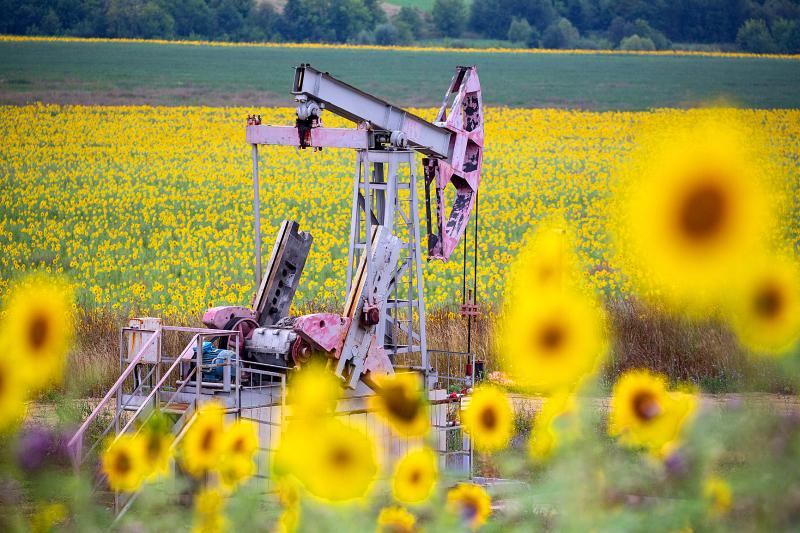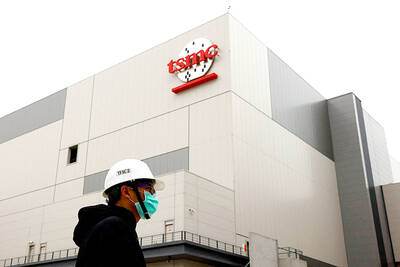Saudi Arabia’s warning to OPEC+ cheaters and short-sellers alike helped oil prices stage their biggest weekly rally since June, despite a grim start to the week as industry heavyweights painted a troubling demand picture for the petroleum complex.
Futures in New York rose 10 percent this week following a show of determination on Thursday by Saudi Arabia, the most influential nation in OPEC, to defend the market.
The Saudis hinted that they are prepared for new production cuts and lambasted OPEC+ members that have cheated on production quotas.

Photo: Bloomberg
Prices briefly fell as much as 1.6 percent on Friday following an announcement from Libyan Field Marshall Khalifa Haftar that he would allow crude production and exports to resume.
However, while Haftar reached the agreement with the country’s deputy prime minister, it was unclear whether the deal that excluded the National Oil Co would actually restart exports.
“Depending on Libyan oil supply coming online seems like it’s a pretty risky bet,” so traders likely were not willing to make sizable wagers on it heading into the weekend, Strategic Energy & Economic Research Inc president Michael Lynch said.
Saudi Arabia’s unambiguous comments on Thursday, though, gave market participants the confidence that they can “rely on OPEC to keep the taps turned off for a bit longer,” Lynch said.
Haftar controls most of eastern Libya, and has halted operations and shipments from his territory as part of a campaign against the internationally recognized Tripoli government.
The OPEC member is pumping just 80,000 barrels a day, but produced 1.2 million a day last year.
Oil reversed last week’s losses on Friday, which pushed West Texas Intermediate (WTI) for October delivery up 0.3 percent to US$41.11 a barrel amid a slew of downbeat demand forecasts from the International Energy Agency to Trafigura Group and BP PLC. The contract is up 10 percent for the week.
Brent crude for November delivery on Friday fell 0.3 percent to settle at US$43.15 a barrel, but rose 8.3 percent for the week.
Helping support prices this week, US government data showed crude and gasoline stockpiles declining. US oil stockpiles are at their lowest since April.
However, crude might not be out of the woods just yet, with distillate supplies at record highs, and refining margins for the fuel deteriorating in the US and Europe.
Meanwhile, rising COVID-19 infections in Europe raised the specter of a return to tighter restrictions that have crippled consumption.
“The oil markets have made a nice recovery from their lows,” helped by the decline in US crude supplies, said Bill O’Grady, executive vice president at Confluence Investment Management LLC in St Louis, Missouri. “But the demand data just doesn’t look all that good.”
There is debate over the state of the global supply picture heading into the end of the year.
Among the latest voices to chime in, Goldman Sachs Group Inc said that global oil inventories should draw down this month and the market is likely to see a deficit of 3 million barrels a day in the fourth quarter of this year.
That comes after conflicting views this week out of Vitol Group BV and Trafigura Group Ptd Ltd (托克集團) about whether supplies would shrink or head back into surplus by year-end.
On a positive note, the spread between WTI’s nearest contracts strengthened to its narrowest contango structure in roughly a month. A narrowing contango signals easing concerns of oversupply.
The spread “tends to either blow out or tighten as you approach expiration, but it’s supported by the fundamentals here,” said Bob Yawger, head of the futures division at Mizuho Securities Co. “When you have the contango start to narrow, owners of crude oil are going to be less likely to stuff barrels into storage.”
Companies operating in the Gulf of Mexico might see further storm-related disruption, even as the region still recovers from Hurricane Sally with more than 21 percent of oil production shut in.
Among companies preparing for a tropical depression heading for the region, Royal Dutch Shell PLC said it is shutting its Perdido oil and natural gas production hub in the western Gulf of Mexico.
Additional reporting by AFP, with staff writer

Stephen Garrett, a 27-year-old graduate student, always thought he would study in China, but first the country’s restrictive COVID-19 policies made it nearly impossible and now he has other concerns. The cost is one deterrent, but Garrett is more worried about restrictions on academic freedom and the personal risk of being stranded in China. He is not alone. Only about 700 American students are studying at Chinese universities, down from a peak of nearly 25,000 a decade ago, while there are nearly 300,000 Chinese students at US schools. Some young Americans are discouraged from investing their time in China by what they see

Taiwan Semiconductor Manufacturing Co (TSMC, 台積電), the world’s largest contract chipmaker, yesterday reported record sales for the first quarter, which analysts attributed to solid demand for emerging technologies. Consolidated revenue totaled NT$592.64 billion (US$18.51 billion) in the January-to-March period, up 16.5 percent from a year earlier, but down 5.26 percent from the previous quarter, TSMC said in a statement. The first-quarter revenue beat analysts’ average projection of NT$579.5 billion, Bloomberg News reported. That performance lends weight to expectations that the world’s most valuable chipmaker would return to solid growth this year after weathering a post-COVID-19-pandemic cratering of smartphone and computer sales. TSMC is budgeting

HUALIEN BRANCH: The company had been planning to rebuild the hotel before it was damaged in the quake and vowed to give affected employees the option to transfer The owner of Chateau de Chine Hualien (花蓮翰品酒店) is planning to lay off 86 workers after shutting down the hotel due to damage it sustained in a powerful earthquake on Wednesday last week, the Ministry of Labor said yesterday. The hotel has submitted a layoff report to the Hualien County Government and expects to let 69 workers go this month and 17 next month, the ministry said. LDC Hotels & Resorts Group (雲朗觀光集團), the owner of Chateau de Chine Hualien, confirmed the layoff plan in a statement yesterday. LDC said the hotel has been closed since Wednesday last week when the temblor occurred

US CONSCULTANT: The US Department of Commerce’s Ursula Burns is a rarely seen US government consultant to be put forward to sit on the board, nominated as an independent director Taiwan Semiconductor Manufacturing Co (TSMC, 台積電), the world’s largest contract chipmaker, yesterday nominated 10 candidates for its new board of directors, including Ursula Burns from the US Department of Commerce. It is rare that TSMC has nominated a US government consultant to sit on its board. Burns was nominated as one of seven independent directors. She is vice chair of the department’s Advisory Council on Supply Chain Competitiveness. Burns is to stand for election at TSMC’s annual shareholders’ meeting on June 4 along with the rest of the candidates. TSMC chairman Mark Liu (劉德音) was not on the list after in December last